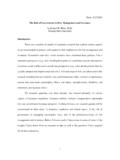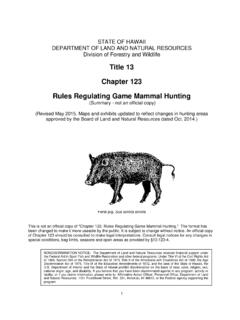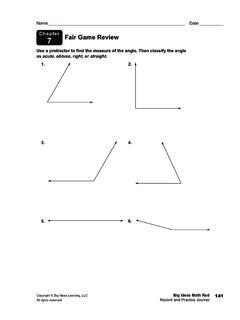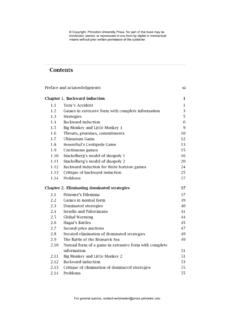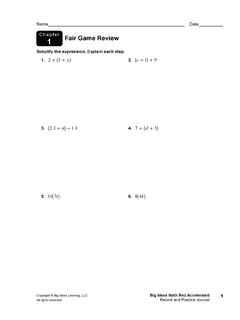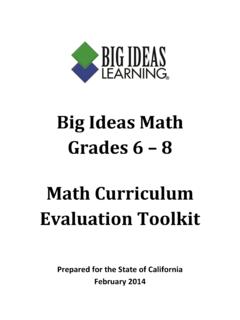Transcription of Chapter 3 : Dynamic Game Theory.
1 Chapter 3 : Dynamic game theory . In the previous Chapter we focused on static games . However for many important economic applications we need to think of the game as being played over a number of time periods, making it Dynamic . A game can be Dynamic for two reasons. First, the interaction between players may itself be inherently Dynamic . In this situation players are able to observe the actions of other players before deciding upon their optimal response. In contrast static games are ones where we can think of players making their moves simultaneously. Second, a game is Dynamic if a one-off game is repeated a number of times, and players observe the outcome of previous games before playing later games . In section we consider one-off Dynamic games , and in section we analyse repeated games . Dynamic One-Off games . An essential feature of all Dynamic games is that some of the players can condition their optimal actions on what other players have done in the past. This greatly enhances the strategies available to such players, in that these are no longer equivalent to their possible actions.
2 To illustrate this we examine the following two period Dynamic entry game, which is a modified version of the static game used in Exercise There are two firms (A and B) that are considering whether or not to enter a new market. Unfortunately the market is only big enough to support one of the two firms. If both firms enter the market then they will both make a loss of 10 million. If only one firm enters the market, that firm will earn a profit of 50 million, and the other firm will just break even. To make this game Dynamic we assume that firm B observes whether firm A has entered the market before it decides what to do. This game can be represented by the extensive form diagram shown in Figure Firm AFirm BFirm B(- 10m , - 10m)( 50m , 0)(0 , 50m)(0 , 0)EnterStayEnterStayStayOutOutOutEnter Figure The Dynamic Entry Game in Extensive Form. In time period 1 firm A makes its decision. This is observed by firm B which decides to enter or stay out of the market in period 2. In this extensive form game firm B s decision nodes are separate information sets.
3 (If they were in the same information set they would be connected by a dashed line.) This means that firm B observes firm A s action before making its own decision. If the two firms were to make their moves simultaneously then firm B would have only two strategies. These would be to either enter or stay out of the market. However because firm B initially observes firm A s decision it can make its decision conditional upon what firm A does. As firm A has two possible actions, and so does firm B, this means that firm B has four (2 x 2) strategies. We can list these as Always enter the market whatever firm A does. Always stay out of the market whatever firm A does. Do the same as firm A. Do the opposite of firm A. Recognizing that firm B now has these four strategies we can represent the above game in normal form. This is shown in Figure Having converted the extensive form game into a normal form game we can apply the two stage method for finding pure strategy Nash equilibria, as explained in the previous Chapter .
4 First, we identify what each player s optimal strategy is in response to what the other players might do. This involves working through each player in turn and determining their optimal strategies. This is illustrated in the normal form game by underlining the relevant payoff. Second, a Nash equilibrium is identified when all players are playing their optimal strategies simultaneously. Firm B Firm A Figure The Dynamic Entry Game in Normal Form. As shown in Figure this Dynamic entry game has three pure strategy Nash equilibria. In these three situations each firm is acting rationally given its belief about what the other firm might do. Both firms are maximizing their profits dependent upon what they believe the other firm s strategy is. One way to understand these possible outcomes is to think of firm B making various threats or promises, and firm A acting accordingly. We can therefore interpret the three Nash equilibria as follows: 1. Firm B threatens to always enter the market irrespective of what firm A does.
5 If firm A believes this threat it will stay out of the market. 2. Firm B promises to always stay out of the market irrespective of what firm A does. If firm A believes this promise it will certainly enter the market. 3. Firm B promises to always do the opposite of what firm A does. If firm A believes this promise it will again enter the market. In the first two Nash equilibria firm B s actions are not conditional on what the other firm does. In the third Nash equilibrium firm B does adopt a conditional strategy. A conditional strategy is where one player conditions their actions upon the actions of at least one other player in the game. This concept is particularly important in repeated games , and is considered in more detail in the next section. In each of the equilibria firm A is acting rationally in accordance with its beliefs. However this analysis does not consider which of its beliefs are themselves rational. This raises the interesting question Could firm A not dismiss some of firm B s threats or promises as mere bluff ?
6 This raises the important issue of credibility. The concept of credibility comes down to the question Is a threat or promise believable ? In game theory a threat or promise is only credible if it is in that player s interest to carry it out at the appropriate time. In this sense some of firm B s statements are not credible. For example, firm B may threaten to always enter the market irrespective of what firm A does, but this is not credible. It is not credible because if firm A enters the market then it is in firm B s interest to stay out. Similarly the promise to always stay out of the market is not credible because if firm A does not enter then it is in firm B s interest to do so. Assuming that player s are rational, ALWAYS ENTER ALWAYS STAY OUT SAME AS FIRM A OPPOSITE OF FIRM A ENTER - 10m - 10m 50m 0 - 10m - 10m 50m 0 STAY OUT 0 50m 0 0 0 0 0 50m and that this is common knowledge, it seems reasonable to suppose that player s only believe credible statements.
7 This implies that incredible statements will have no effect on other players behaviour. These ideas are incorporated into an alternative equilibrium concept to Nash equilibrium (or a refinement of it) called subgame perfect Nash equilibrium. a. Subgame Perfect Nash Equilibrium. In many Dynamic games there are multiple Nash equilibria. Often, however, these equilibria involve incredible threats or promises that are not in the interests of the players making them to carry out. The concept of subgame perfect Nash equilibrium rules out these situations by saying that a reasonable solution to a game cannot involve players believing and acting upon incredible threats or promises. More formally a subgame perfect Nash equilibrium requires that the predicted solution to a game be a Nash equilibrium in every subgame. A subgame, in turn, is defined as a smaller part of the whole game starting from any one node and continuing to the end of the entire game, with the qualification that no information set is subdivided.
8 A subgame is therefore a game in its own right that may be played in the future, and is a relevant part of the overall game. By requiring that a solution to a Dynamic game must be a Nash equilibrium in every subgame amounts to saying that each player must act in their own self interest in every period of the game. This means that incredible threats or promises will not be believed or acted upon. To see how this equilibrium concept is applied, we continue to examine the Dynamic entry game discussed above. From the extensive form of this game, given in Figure , we can observe that there are two subgames, one starting from each of firm B s decision nodes. For the predicted solution to be a subgame perfect Nash equilibrium it must comprise a Nash equilibrium in each of these subgames. We now consider each of the Nash equilibria identified for the entire game to see which, if any, are also a subgame perfect Nash equilibrium. 1. In the first Nash equilibrium firm B threatens to always enter the market irrespective of what firm A does.
9 This strategy is, however, only a Nash equilibrium for one of the two subgames. It is optimal in the subgame beginning after firm A has stayed out but not in the one where firm A has entered. If firm A enters the market it is not in firm B s interest to carry out the threat and so it will not enter. This threat is not credible and so should not be believed by firm A. This Nash equilibrium is not subgame perfect. 2. In the second Nash equilibrium firm B promises to always stay out of the market irrespective of what firm A does. Again this is only a Nash equilibrium for one of the two subgames. It is optimal in the subgame beginning after firm A has entered but not in the one when firm A has stayed out . If firm A stays out of the market, it is not in the interest of firm B to keep its promise, and so it will enter. This promise is not credible, and so should not be believed by firm A. Once more this Nash equilibrium is not subgame perfect. 3. The third Nash equilibrium is characterized by firm B promising to do the opposite of whatever firm A does.
10 This is a Nash equilibrium for both subgames. If firm A enters it is optimal for firm B to stay out, and if firm A stays out it is optimal for firm B to enter. This is a credible promise because it is always in firm B s interest to carry it out at the appropriate time in the future. This promise is therefore believable, and with this belief it is rational for firm A to enter the market. The only subgame perfect Nash equilibrium for this game is that firm A will enter and firm B will stay out. This seems entirely reasonable given that firm A has the ability to enter the market first. Once firm B observes this decision it will not want to enter the market, and so firm A maintains its monopoly position. The way we solved this Dynamic game has been rather time consuming. This was done so that the concept of subgame perfection may be better understood. Fortunately there is often a quicker way of finding the subgame perfect Nash equilibrium of a Dynamic game. This is by using the principle of backward induction.

